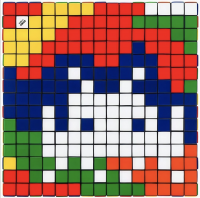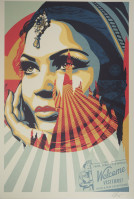
Details
Artist
Styles
Signed, numbered and dated // Invader’s Scream II (2007) is a limited-edition screen print that exemplifies the artist’s signature pixelated style, derived from his use of mosaic tiles and Rubik’s cube aesthetics. The artwork is composed of small, colorful squares in a grid pattern, reminiscent of digital pixels, forming an abstracted version of Edvard Munch’s iconic The Scream. The colors—red, blue, green, white, and orange—are strategically placed to create a sense of movement and distortion, characteristic of Munch’s original piece, but rendered in a highly modern, digital format. This print is a striking example of Invader's ability to blend classic art with contemporary digital and pop culture influences.
Scream II, 2007
form
Medium
Size
40 x 50 cm
- Inches
- Centimeters
Edition
Price
Details
Artist
Styles
Signed, numbered and dated // Invader’s Scream II (2007) is a limited-edition screen print that exemplifies the artist’s signature pixelated style, derived from his use of mosaic tiles and Rubik’s cube aesthetics. The artwork is composed of small, colorful squares in a grid pattern, reminiscent of digital pixels, forming an abstracted version of Edvard Munch’s iconic The Scream. The colors—red, blue, green, white, and orange—are strategically placed to create a sense of movement and distortion, characteristic of Munch’s original piece, but rendered in a highly modern, digital format. This print is a striking example of Invader's ability to blend classic art with contemporary digital and pop culture influences.
- Recently Added
- Price (low-high )
- Price (high-low )
- Year (low-high )
- Year (high-low )
Invader
Rubik Kubrick I - Clockwork Orange (Alex), 2006
Limited Edition Print
Screen-print
GBP 5,000 - 7,000
What is graffiti art?
Graffiti art refers to drawings and writings that are painted, scratched, or scribbled on walls or other surfaces, typically in public spaces. This art form ranges from small tags to elaborate wall paintings. Graffiti has been in existence since ancient times, with examples dating back to the Roman Empire, Ancient Greece, and Ancient Egypt.




















